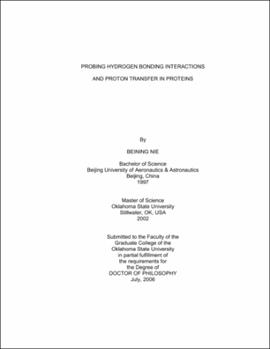| dc.contributor.advisor | Xie, Aihua | |
| dc.contributor.author | Nie, Beining | |
| dc.date.accessioned | 2013-11-26T08:26:35Z | |
| dc.date.available | 2013-11-26T08:26:35Z | |
| dc.date.issued | 2006-07 | |
| dc.identifier.uri | https://hdl.handle.net/11244/6907 | |
| dc.description.abstract | Scope and Method of Study: Hydrogen bonding is a fundamental element in protein structure and function. Breaking a single hydrogen bond may impair the stability of a protein. It is therefore important to probe dynamic changes in hydrogen bonding interactions during protein folding and function. Time-resolved Fourier transform infrared spectroscopy is highly sensitive to hydrogen bonding interactions. However, it lacks quantitative correlation between the vibrational frequencies and the number, type, and strength of hydrogen bonding interactions of ionizable and polar residues. We employ quantum physics theory based ab initio calculations to study the effects of hydrogen bonding interactions on vibrational frequencies of Asp, Glu, and Tyr residues and to develop vibrational spectral markers for probing hydrogen bonding interactions using infrared spectroscopy. In addition, proton transfer process plays a crucial role in a wide range of energy transduction, signal transduction, and enzymatic reactions. We study the structural basis for proton transfer using photoactive yellow protein as an excellent model system. Molecular dynamics simulation is employed to investigate the structures of early intermediate states. Quantum theory based ab initio calculations are used to study the impact of hydrogen bond interactions on proton affinity and proton transfer. | |
| dc.description.abstract | Findings and Conclusions: Our extensive density function theory based calculations provide rich structural, spectral, and energetic information on hydrogen bonding properties of protonated side chain groups of Asp/Glu and Tyr. We developed vibrational spectral markers and 2D FTIR spectroscopy for structural characterization on the number and the type of hydrogen bonding interactions of the COOH group of Asp/Glu and neutral phenolic group of Tyr. These developments greatly enhance the power of time-resolved FTIR spectroscopy as a major experimental tool for structural characterization of functionally important intermediate states of proteins. Our MD simulations on the structures of photoactive yellow protein (PYP) and its photoproducts provide deep insight into the much-debated structural nature of chromophore photo-isomerization. Our simulation data of three plausible photoproducts provide a specific guide on how to use time-resolved infrared spectroscopy to identify which photoproduct is formed after photoisomerization. Our data also indicate that hydrogen bond with Tyr42 may be crucial to increase the proton affinity of the chromophore and trigger the intra-protein proton transfer during PYP photoreceptor activation. | |
| dc.format | application/pdf | |
| dc.language | en_US | |
| dc.rights | Copyright is held by the author who has granted the Oklahoma State University Library the non-exclusive right to share this material in its institutional repository. Contact Digital Library Services at lib-dls@okstate.edu or 405-744-9161 for the permission policy on the use, reproduction or distribution of this material. | |
| dc.title | Probing hydrogen bonding interactions and proton transfer in proteins | |
| dc.contributor.committeeMember | Hauenstein, Robert H. | |
| dc.contributor.committeeMember | McMahon, Benjamin H. | |
| dc.contributor.committeeMember | Hoff, Wouter D. | |
| osu.filename | Nie_okstate_0664D_1980.pdf | |
| osu.accesstype | Open Access | |
| dc.type.genre | Dissertation | |
| dc.type.material | Text | |
| dc.subject.keywords | fourier transform infrared spectroscopy | |
| dc.subject.keywords | density functional theory | |
| dc.subject.keywords | proton transfer | |
| dc.subject.keywords | hydrogen bond | |
| dc.subject.keywords | 2d infrared spectroscopy | |
| dc.subject.keywords | molecular dynamics simualtion | |
| thesis.degree.discipline | Physics | |
| thesis.degree.grantor | Oklahoma State University | |
